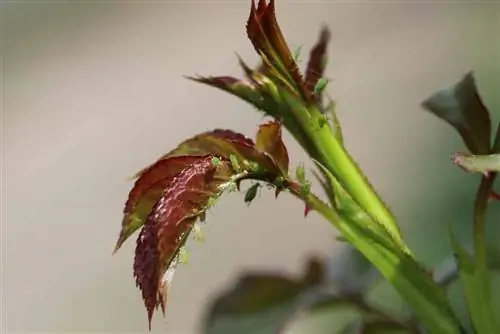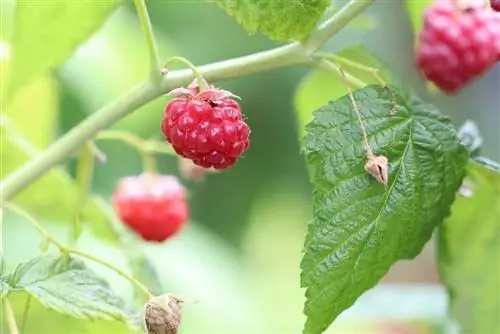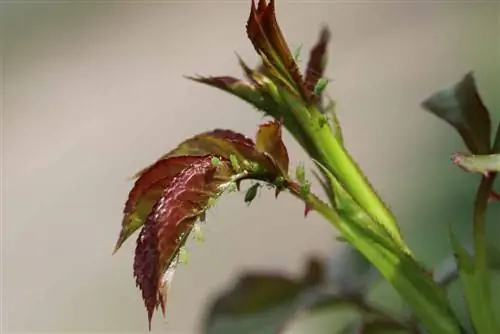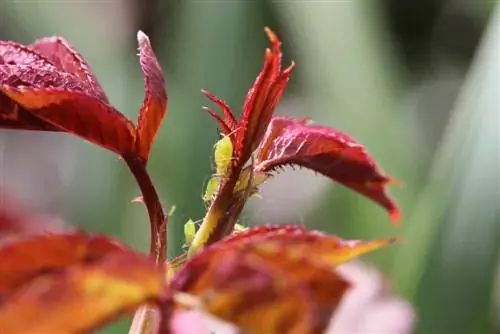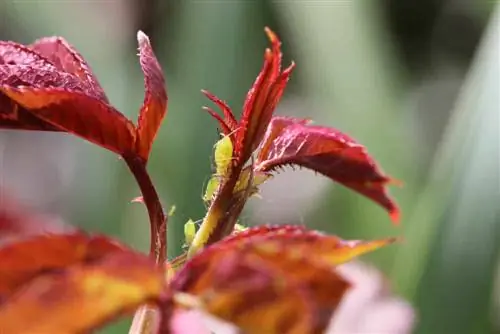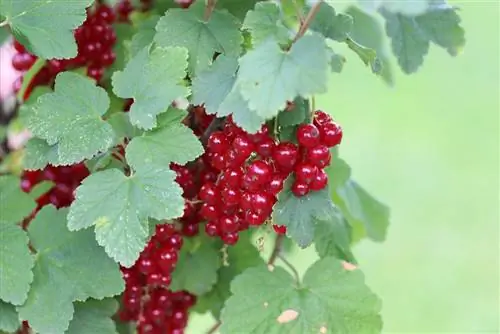- Author admin [email protected].
- Public 2023-12-17 03:39.
- Last modified 2025-06-01 06:48.
Widespread, feared and repeatedly fought with strong weapons - aphids are among the hobby gardener's most unpopular pests. The green, gray, brown or yellow suckers, which grow to between three and seven centimeters in size, love the sap of certain native plants. Persistent infestation eventually leads to honeydew excretions, stunted shoot tips and stunted flowers. There are numerous effective means available to successfully combat the annoying pests that primarily attack weak and sick plants.
Fighting aphids successfully - preliminary considerations
The choice of a suitable remedy against aphids should always be done very carefully, as certain initial criteria must be observed. This includes the following questions:
- Is this a year-round houseplant or a temporary houseplant?
- Should a decorative houseplant or a pleasure plant be treated?
- How far has the infestation already progressed?
The location issue is particularly important to consider; In particular, plants that are on the balcony or terrace during the warm season and are only brought into the house in the winter months carry a high risk. Getting used to the climatic conditions in the house makes the plant more vulnerable and weaker. In addition, dry heating air and the proximity to other plants ensure a higher risk and good conditions for aphids. If the plant is already infested by a few specimens, the lice spread explosively in the new environment.
Therefore:
Before moving an outdoor plant to its winter quarters, the individual leaves and shoots must be carefully examined. If necessary, the plant should be left outside for a few more days to combat smaller aphid populations. Before moving, the plant must be free of pests. It is also important to consider whether it is an ornamental or a pleasure plant, as houseplants also include some species that produce fruits or edible leaves.
These include, for example:
- various types of chili (especially Siberian house pepper)
- Lemon or tangerine trees
- Lemon herb
- Stevia
If it is an edible houseplant, treatment may only be carried out with the help of mechanical control (e.g. collecting the lice, using yellow stickers) or by using biological agents. However, chemical preparations can also be used for all other houseplants. Although it has proven successful in the greenhouse and outdoors, the use of certain beneficial insects (e.g. ladybirds) indoors is not recommended; The propagation of such species is difficult in closed rooms, so beneficial insects are mainly used in greenhouses or outdoors.
Initial measure: spraying the plant
If the aphid infestation is still in its early stages, it is often sufficient to treat the plant with water; The aphids fall from the plant through the jet of water. If the plants are small, the affected parts of the plant can be sprayed with water. Larger specimens are best placed in the shower and rinsed thoroughly. It has proven useful to hold the plant at an angle and spray the leaves from different angles in order to particularly reach the undersides of the leaves and the leaf axils; Experience has shown that this is where most pests reside. To protect the soil, a plastic bag is placed on the substrate and placed over the pot.
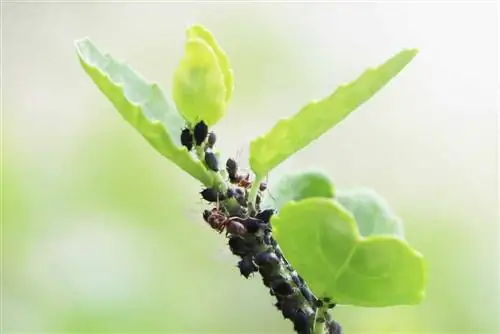
Caution:
Not every plant is suitable for showering; In particular, delicate plants with delicate leaves can easily be damaged by this treatment.
Mechanical collection for small infestations
If aphids only appear sporadically on the plant, they can also be removed using mechanical treatment:
- easy collection
- Stripping with a brush
- Treatment with a hairdryer
When treating with a hairdryer, it is held at an angle; The lice are blown off the leaves by the hot air or jump off the plant. Caution: It is important to ensure that there is a sufficient safety distance between the hairdryer and the plant; the hot air could damage the leaves of the plants. It is also important to remember that this measure does not kill the aphids. It is therefore a good idea to remove neighboring plants from the window sill before fighting.
For winged lice: use of yellow stickers
When fighting aphids, it is often not possible to completely clear the window sill and remove all neighboring plants. In order to protect the neighboring plants, yellow stickers can be used. Winged variants of lice in particular stick to the boards and thus prevent further spread. But specimens without wings are also attracted to the yellow color of the stickers - as long as they are within reach. The pests stick to the yellow stickers and die.
For pleasure plants: control with nettle broth
If it is an ornamental plant that contains edible parts, it has proven useful to use plant-based products to combat aphids. Nettle decoction is particularly effective in this context and can be made using the following recipe:
- 1. 100g of nettles are mixed with one liter of water.
- 2. The mixture is cooked and then cooled again.
- 3. The leaves are left in water for 2 days.
- 4. The nettles are then passed through a sieve.
- 5. The brew is poured into a squeeze bottle.
The plant is sprayed with the solution until it is dripping wet. The ingredients in nettle not only drive away aphids, but also strengthen the plant's defenses. To increase the effect, fresh leaves should always be used.
Tip:
The production of nettle decoction is accompanied by a strong odor. It has therefore proven useful to produce these outdoors.
Biological agents: oil-based solutions
If aphids are more infested, the plant can be treated with oil-based spray solutions. The rapeseed or neem oil often used for this covers the pests with an oil film and then causes them to suffocate. To prepare the oil solution, a total of five liters of water are mixed with 90ml of the selected oil; The solution is then poured into a squirt bottle.
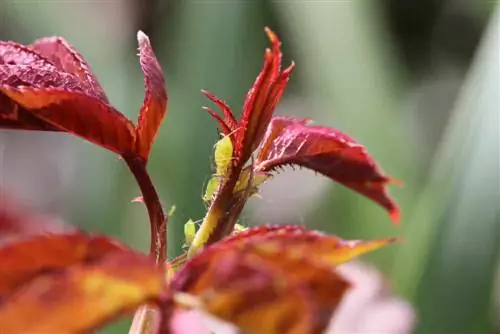
When treating the plant, it is important to ensure that all areas on the underside of the leaves are carefully wetted - because this is where most lice are located. When using them, it should also be borne in mind that oil preparations primarily work against pest larvae. The effect is therefore delayed and the application must be repeated. In addition, the following instructions should be observed when using:
- The treatment is best done outdoors.
- Thick-leaved plants in particular benefit from the application.
- Thin-leaved plants tend to stick together, so use with care
- If used over large areas, rinse the plant afterwards
Inexpensive pest control: potassium soap solution
One of the classic anti-aphid remedies is the typical soap solution, which is particularly inexpensive to produce. Both unscented curd soaps and soft soaps without additives are used. However, experts advise against using classic soaps with synthetic ingredients as these can harm the plants.
To make the soap solution, the hobby gardener takes a liter of water, which is mixed with a tablespoon of soft soap. To intensify the effect, a splash of spirit helps. The finished solution is then poured into a squirt bottle and then administered. Before treatment, the plant must be carefully covered; The solution should under no circumstances get into the ground. A plastic bag placed over the edge of the substrate provides protection here. After administering the solution, the following points should be noted:
- Allow the solution to dry thoroughly
- Place the plant in a bright place for two to three days
- Remove dead pests from leaves using water
- Consistent pest control in the following days
- possibly use the soap solution again
Chemical agents for stubborn infestations
If the plant that is to be treated is purely ornamental, chemical agents can also be used to combat it. In this context, pyrethrum-based plant protection products are among the classics; it is a highly effective pesticide, but breaks down in a short time. As a typical contact poison, the substance only affects the pest externally - and is not absorbed by the plant. In this way, damage to the crop can be minimized.
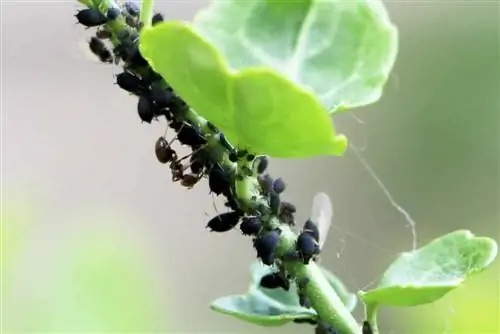
To combat aphids, the hobby gardener wets the affected parts of the plant with the contact poison. Even if there are no lice visible on the top, they still need to be treated - sometimes the eggs are not yet clearly visible. When using pyrethrum, the following aspects should also be taken into account:
- Gloves must be worn when using
- Pay close attention to dosage
- Repeat application after 7-9 days
No matter which pesticide you choose, what is important is good stamina when fighting aphids. They are extremely stubborn pests that keep coming back and adapt to changing circumstances. But if you examine your plants regularly and take countermeasures even at the slightest infestation, you will be able to get the infestation under control using the means mentioned.

